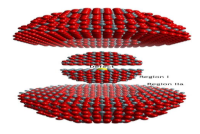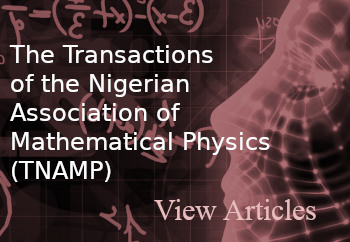STUDY OF THE STRUCTURE AND DEFECT CHEMISTRY OF ThO2 AS A NUCLEAR FUEL
DOI:
https://doi.org/10.60787/jnamp.v67i2.363Keywords:
Thorium dioxide, GULP, Potential models, Atomistic simulation, DefectAbstract
Thorium fuel cycle is a globally known nuclear fuel alternative, having good physical, neutronic, and chemical properties. However, there are limited knowledge on the potentials, models, and mechanical properties of ThO2 compared to UO2. Thus, the present study investigated the structural properties and defect chemistry of ThO2 by atomistic computer simulation technique using General Utility Lattice Programme (GULP) code. The structural properties were calculated which showed good agreement with the literature. The defects formation energies in ThO2 of the isolated and cluster atoms are calculated. It is found that the interstitial Th4+ defect is the most probable defect with an energy release of 60.19 eV, while oxygen Frenkel pair is the most energetically probable for defect cluster. The good agreement shown between the present simulation results with the experimental values supports the validity of the method and the structural and mechanical suitability of ThO2 as a potential nuclear fuel.
Downloads
References
Ault, T., Krahn, S., and Croff, A. (2017). Thorium fuel research and literature: Trends and insights from eight decades of diverse projects and elvolving priorities. Annals of Nuclear Energy, 110, 726-738.
Galahom, A. A. (2017). Minimization of the fission product waste by using thorium-based fuel instead of uranium dioxide. Nuclear Engineering and Design, 314, 165-172.
Schaffer, M. B. (2013). Abundant thorium as an alternative nuclear fuel: Important waste disposal and weapon proliferation advantages. Energy Policy, 60, 4-12.
Ünak, T. (2000). What is the potential use of thorium in the future energy production technology? Progress in Nuclear Energy, 37 (1), 137-144.
Uguru, E. H., Abdul Sani, S. F., Khandaker, M. U., Rabir, M. H., Karim, J. A., Onah, D. U., and Bradley, D. A. (2021). Burn-up calculation of the neutronic and safety parameters of thorium-uranium mixed oxide fuel cycle in a Westinghouse small modular reactor. International Journal of Energy Research, 45, 12013-12028.
Lu, Y., Yang, Y., and Zhang, P. (2012). Thermodynamic properties and structural stability of thorium dioxide. Journal of Physics: Condensed Matter, 24, 225801.
Williams, N. R., Molinari, M., Parker, S. C., & Storr, M. T. (2015). Atomistic investigation of the structure and transport properties of tilt grain boundaries of UO2. Journal of Nuclear Materials, 458, 45-55.
Chang, H., Yang, Y., Jing, X., and Xu, Y. (2006). Thorium-based fuel cycles in the modular high temperature reactor. Tsinghua Science and Technology, 11, 731-738.
Lang, S., and Knudsen, F. (1956). Some physical properties of high‐density thorium dioxide. Journal of the American Ceramic Society, 39, 415-424.
Macedo, P., Capps, W., and Wachtman, J. (1964). Elastic constants of single crystal ThO2 at 25° C. Journal of the American Ceramic Society, 47, 651-651.
Osaka, M., Adachi, J., Kurosaki, K., Uno, M., and Yamanaka, S. (2007). Molecular dynamics study on defect structure of gadolinia-doped thoria. Journal of Nuclear Science and Technology, 44, 1543-1549.
Nadeem, M., Akhtar, M., Shaheen, R., Haque, M., and Khan, A. (2001). Interatomic potentials for some binary oxides. Journal of Materials Science and Technology, 17, 638-642.
Behera, R. K., and Deo, C. S. (2012). Atomistic models to investigate thorium dioxide (ThO2). Journal of Physics: Condensed Matter, 24, 215405.
Read, M. S., and Jackson, R. A. (2010). Derivation of enhanced potentials for uranium dioxide and the calculation of lattice and intrinsic defect properties. Journal of Nuclear Materials, 406, 293-303.
Bird, R. A., and Read, M. S. (2017). Derivation of enhanced potentials for cerium brannerite and the calculation of lattice and intrinsic defect properties. Nuclear Instruments and Methods in Physics Research Section B: Beam Interactions with Materials and Atoms, 393, 6367.
Gale, J. D. (1997). GULP: A computer programme for the symmetry-adapted simulation of solids. Journal of the Chemical Society., Faraday TRANSACTIONS, 93, 629- 637.
Minervini, L., Zacate, M. O., and Grimes, R. W. (1999). Defect cluster formation in M2O3-doped CeO2. Solid State Ionics, 116, 339-349.
Catlow, C. R. A. (1997). Computer modelling in inorganic crystallography. Academic Press.
Walker, J., and Catlow, C. R. A. (1981). Structural and dynamic properties of UO2 at high temperatures. Journal of Physics C: Solid State Physics, 14, 1979.
Mott, N. and Littleton, M. (1989). Conduction in polar crystals: Electrolytic conduction in solid salts. Journal of the Chemical Society, Faraday Transaction 2: Molecular and Chemical Physics, 85, 565-579.
Read, M. S., Walker, S. R., and Jackson, R. A. (2014). Derivation of enhanced potentials for plutonium dioxide and the calculation of lattice and intrinsic defect properties. Journal of Nuclear Materials, 448, 20-25.
Lewis, G., and Catlow, C. (1986). Defect studies of doped and undoped barium titanate using computer simulation techniques. Journal of Physics and Chemistry of Solids, 47, 89-97.
Arima, T., Yamasaki, S, Inagaki. Y., and Idemitsu, K. (2005). Evaluation of thermal properties UO2 and PuO2 by equillibrium dynamics simulations from 300 to 2000 K. Journal of Alloys and Compounds, 400, 43-93.
March, N. H., (2013). Electron correlation in molecules and condensed phases. Springer Science & Business Media, New York, NY.
Olsen, J. S., Gerward, L., Kanchana, V., and Vaitheeswaran, G. (2004). The bulk modulus of ThO2 – an experimental and theoretical study, Journal of Alloys and Compounds, 381, 3740.

Downloads
Published
Issue
Section
License
Copyright (c) 2024 The Journals of the Nigerian Association of Mathematical Physics

This work is licensed under a Creative Commons Attribution-NonCommercial-ShareAlike 4.0 International License.




